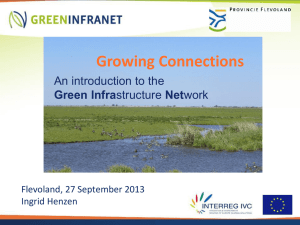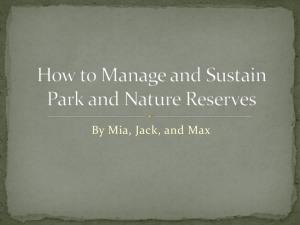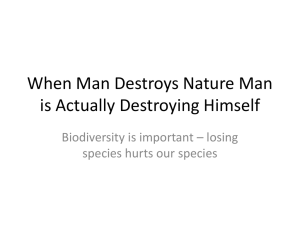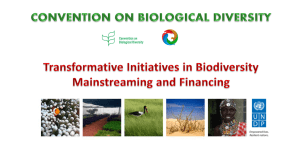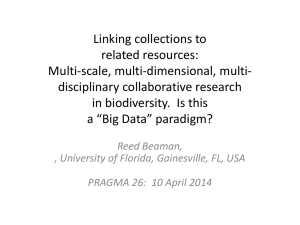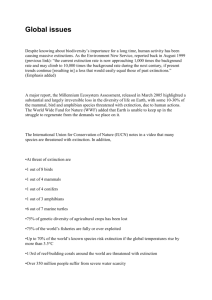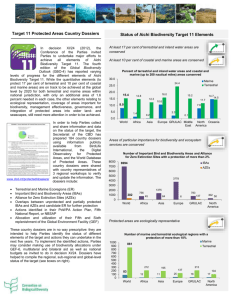the full ppt presentation
advertisement
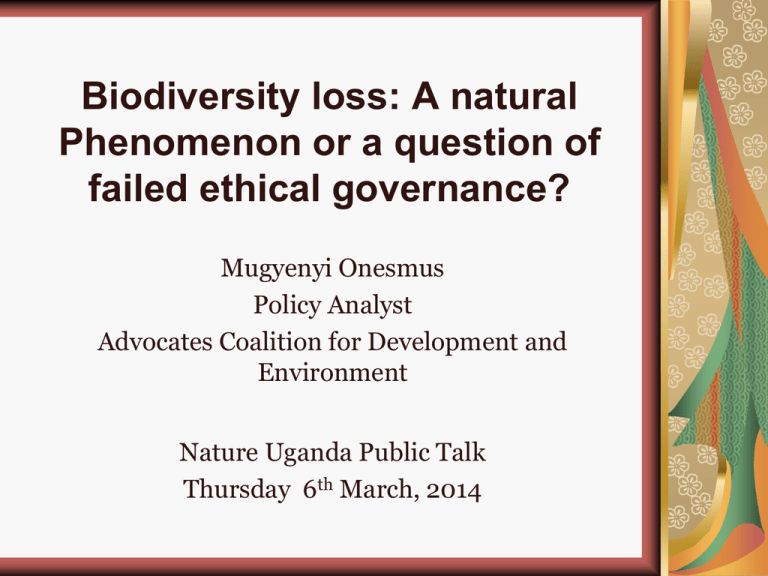
Biodiversity loss: A natural Phenomenon or a question of failed ethical governance? Mugyenyi Onesmus Policy Analyst Advocates Coalition for Development and Environment Nature Uganda Public Talk Thursday 6th March, 2014 Introduction Biodiversity governance implies coordination multiple policies at different levels to achieve desired outcomes. Biodiversity loss is both a product of natural trends (speciation-evolution of species) and erosion of ethical governance. However the current pace, is largely influenced by degeneration of the obligation to conserve. 2 Introduction… An ethic, ecologically, is a limitation on freedom of action in the struggle for existence.” Do we feel obliged to conserve biological diversity? Why? Use values (associated with resource exploitation) and non use values- We appreciate it (aesthetic value (pleasure/appreciation), We think we should conserve it (Moral value) 3 Introduction… 4 Trends of biodiversity loss In 2010, The International Union for Conservation of Nature (IUCN) noted that many species are threatened with extinction. At threat of extinction are 1 out of 8 birds 1 out of 4 mammals 1 out of 3 amphibians 6 out of 7 marine turtles 75% of genetic diversity of agricultural crops has been lost 75% of the world’s fisheries are fully or over exploited 1/3rd of reef-building corals around the world are threatened with extinction. 5 Trends of biodiversity loss The Millennium ecosystem report 2005 indicate that 10-30% of the mammals, birds ,amphibians are threatened to extinction. The total number of species listed as endangered increased from 5,205 in 1996 to 5,435 in 2001. “More details see IUCN red list” and Uganda Biodiversity Status Reports” 6 Biodiversity loss-Why? As explained in the UN’s 3rd Global Biodiversity Outlook, the rate of biodiversity loss has not been reduced because the 5 principle pressures on biodiversity are persistent, even intensifying: Habitat loss and degradation Climate change Excessive nutrient load and other forms of pollution Over-exploitation and unsustainable use Invasive alien species 7 Biodiversity loss-Why? • • • • • Republic of Uganda Report on Implementation of Rio commitments to sustainable development,2012 identified challenges as: Weak institutional capacities. Poor coordination. Corruption Lack of scientific data Demographic issues 8 What is the cost? Ecosystem services-services that would be paid for by nature have to be bought-pollination etc. Reduced food security. Increased disease burden. Climate change and associated costs. 9 Local estimations-What is the cost? Biodiversity loss-UGX506 billion/year. Wildlife loss-up to UGX353billion /year. Forest degradation-UGX3.756billion/year. Soil degradation-UGX225billion/year. Rangeland degradation UGX815million/year. Wetland encroachment-UGX2billion/year “What is the deficit-should we be talking of economic growth?” 10 Key Elements of Governance Critical for biodiversity Governance o State Capacity – related to a states’ power and ability to enforce rules that are consistent and predictable. o Rule of law – that establishes among other things property rights and limits the states’ discretion in manipulating those rules. o Democratic institutions – that further limit exercise of state discretion by holding governments accountable to their citizens. o An active citizenry - devoid of fear and manipulation that acts as front line defenders of democracy 11 Challenges for Biodiversity Governance o Diminishing State capacity to arrest the trend of environmental degradation o o o o Failure to restore critical wetland ecosystems. Widespread land degradation and soil erosion causing widespread economic and livelihood losses. The increasing menace of polythene and polythene bag materials. The State and state agencies acting more as agents of industry. (Leasing of Buffer Zones, issuing permits to change land use, etc) 12 Challenges… Breakdown of Trust in Government ----eroded by endemic corruption 13 I thank you for Listening 14


